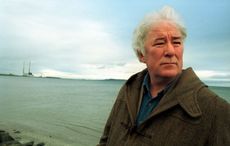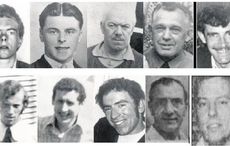I’m a bit ambivalent about St. Patrick’s Day. What is it about March 17 that renders so many people Irish or some version of it, that I don’t recall from living the first twenty-seven years of my life in Ireland?
Everywhere I turn, there are people bragging about their Irish-ness, balancing plastic green bowler hats on their heads and wearing T-shirts emblazoned with a command for everyone to kiss them. Why? Simple. Because they are Irish.
Even politicians are suddenly Irish – usually the American kind and definitely not those from a distinct group in Northern Ireland, where I’m from. It amuses me to imagine how many frazzled interns there must be in these United States, tasked by politicians keen on “the Irish vote,” with finding some verifiable, however microscopic, proof of their Irish heritage.
With vast quantities of green beer flowing to strains of “Danny Boy” and all those perfectly-formed ringlets bouncing heavily on the heads of Irish dancers, I’m beginning to wonder if perhaps I had been absent on St. Patrick’s Day in Ireland. How could I have grown up down the road from Mount Slemish, where a young Saint Patrick tended his sheep, and missed all these shenanigans?
Incidentally, along with a bunch of fresh-faced girls from school, I went to Irish Dancing lessons every week at the Protestant Hall on Railway Street in Antrim, and not one of us had either the ringlets or the very straight backs and long legs of all those Riverdancers first spotted almost twenty years ago on the Eurovision Song Contest.
I have long since forgotten the name of our Irish Dancing teacher and how to do a slip-jig, but I saved all my medals in the red box that held my first Timex watch, and I even brought my lovely dancing costume all the way to America with me.
It hangs in the back of a closet, rather dusty and maybe a bit too reminiscent of Miss Havisham’s wedding dress. Dare I ask my daughter to humor me and try it on? Maybe for St. Patrick’s Day . . .
Then there’s the corned beef and cabbage. With hand on my heart, I can tell you we never had corned beef in our house. There was always the best of sirloin from Stewart’s Butchers, a place with saffron colored sawdust on the floor. I remember tracing lop-sided figures of eight in it with the toes of the leather brogues I wore to school. An imaginative child, I pretended I was cutting through ice on the blades of Harriet’s skates as she spun around a frozen pond in "Tom’s Midnight Garden," a much-loved book that had even made it to a BBC television series.
The young red-faced butchers, in their navy and white striped aprons all smeared with blood and bits of raw beef, looked a bit menacing, especially while sharpening their knives as I ordered a pound of minced beef. As for cabbage, I still associate it with the overcooked vegetables, lumpy custard, and tapioca served for school dinners. Mind you, as my mother will no doubt remind me, when fried up with a bit of good bacon from Golden’s, the wee shop, cabbage was hard to beat, turnip too. But neither cabbage nor turnip had anything to do with St. Patrick. I daresay corned beef and cabbage would have been no more than a coincidence on St. Patrick’s Day four decades ago in Northern Ireland.
And, the shamrocks. For starters, I don’t remember Pat the barman in the Crown Bar in Belfast – where I had manys the ploughman's platter with my college friend, Ruth – taking the time to trace a shamrock on the head of a pint of Guinness for us. Nor do I remember green shamrocks or Celtic knots tattooed with pride on young shoulders; rather, they were carved into the grey headstones that sprouted from old and overgrown graveyards outside country churches.
In spite of Sunday School and sermons from the pulpit, I somehow missed the bit about St. Patrick driving all the snakes out of Ireland, although the story has since crossed my mind on those rare occasions when real snakes have slithered across my path on a hike through the Sonoran desert. Truth be told, I have found these lowly creatures much less poisonous than the human variety.
Now wasn’t St. Patrick very clever to have found in nature a perfect symbol for Father, Son, and Holy Ghost, to help him spread The Word? This was how I learned about the Holy Trinity in Sunday School, and, I always think about it when I recall those delicate shamrocks wilting in the buttonholes of suits worn by Catholic men going to mass on St. Patrick’s Day. Back then, it seemed that most Protestants either “took no notice” of the holiday or characterized it as something reserved for those “on the other side.” Ironic, given the young saint’s passion for spreading Christianity.
By the time I was living and studying in Belfast, St. Patrick’s Day had become a good excuse for an extended pub crawl with a motley crew of art students, engineers, teachers, and male nurses. I recall one such March, when a bunch of us piled in a taxi bound for The Wayside Halt, a pub on the Ballymena line. It stands almost stoic, a nondescript bar on the edge of the dual carriageway between Antrim and Ballymena. It is the kind of place that wouldn’t merit a second look, unremarkable except for those who knew of the horror that had visited on May 24, 1974.
I still remember that St. Patrick's Day trying very hard not to think of the Catholic publican, Sean Byrne, and his brother, Brendan, who had been shot to death, at point blank range, in that very place. To this day, The Wayside Halt lingers in a distant corner of my consciousness, refining my sense of who I am. I learned fairly recently, that one of my father's friends had suggested they call into the pub that night in 1974, for a quick pint, since it was on the road home. Granted, the “quick pint” is something of a paradox back home, and because dad was in a rush to complete his bread deliveries before dark that Friday night, he declined. And, before he reached a neighboring town, the harrowing word had arrived that within the previous hour, Loyalist paramilitaries had barged into the Wayside Halt, and shot at point-blank range, the Byrne brothers. Other pub owners in the Ballymena area had been attacked, their places of business vandalized because they had decided to remain open during the United Workers Council Strike of 1974.
Somehow, over a decade later, Mrs. Byrne had kept going, and on St. Patrick’s Day, she outdid herself, with a giant pot of Irish stew, the likes of which I defy you to find Stateside. Bland to the American taste-buds, I’m sure, but for us, when combined with an aromatic turf fire, a hot Powers whiskey, and someone like Big Micky playing "The Lonesome Boatman" on a tin whistle in the back bar, it was big and bold in flavor. Unforgettable. On such a night, we basked in our Irish identity. We knew who we were.
You are unlikely to find me at the St. Patrick’s Day Parade and Faire in Phoenix Arizona, especially on a 90 degree day, but you might just find me out by the swimming pool with the unlikely sounds of Planxty and Christy Moore filling my backyard and Edna O’Brien’s "Saints and Sinners" in hand.
So if you have an hour or two to be Irish this upcoming St. Patrick's Day, why don't you dip your toes in any of the following:
1. Planxty Live 2004
“When some 12,000 people poured into Vicar St in Dublin and the Glór Irish Music Centre in Ennis, County Clare for Planxty’s first live dates in well over twenty years, it became apparent that these concerts were being celebrated not just by an audience of veteran folk music aficionados, but equally by a whole new generation of younger fans who previously could only dream of how Planxty sounded in the flesh. How beautiful it was to watch sons and daughters with mothers and fathers joined in mutual appreciation of these four musicians and their very unique musical chemistry. In fact, even Planxty’s own children got to see them perform together for the first time.”
2. The Country Girls Trilogy and Epilogue by Edna O’Brien
I love Ms. O’Brien for her story telling as much as I do her ability to make any Irish country girl feel like she was not that odd after all.
3. The Horslips – the original “Dancehall Sweethearts” singing Dearg Doom.
4. Modern Irish Short Stories
If you want to understand the art of the short story as “putting the oak tree back in the acorn,” this little gem is a must. The size of a small bible, it is packed with stories by the likes of Frank O’Connor, Mary Lavin, Bernard McClaverty, George Moore, and a touch of Joyce. We studied it for O-Level English, and it has pride of place on my bookshelf.
5. "Astral Weeks/I Believe I have Transcended"
Van Morrison in full flow at The Hollywood Bowl, mystifying us with a song he once described as “one where you can see the light at the end of the tunnel.” I'm sure purists will be offended, but this live version leaves the original in the dust as far as I'm concerned:
6. Seamus Heaney’s Poetry
When I want to stop the world for a minute and go ‘back home’ to the rhythms of rural County Derry, I listen to Heaney read from "The Haw Lantern," a collection of sonnets he wrote for his mother. And so he is with me still, the way he has always been, whether I'm doing laundry or gardening or any of the mundane tasks he transformed into magical spots of time that make me think of my mother back in Castledawson, County Derry with a great armful of sheets rescued from the clothes-line before the rain begins to fall. Then, the folding, a precise ritual, my father her partner in a dance handed down from one generation to the next. And I’ll hear Seamus Heaney remembering his own mother. My daughter learned those same moves not by the ironing board in my mother’s kitchen, but before the fog rolled in on the end of a windy afternoon on the sandy edges of California. Folding a blue beach blanket, edge to edge, while unbeknownst to us, my husband took photographs and wrote our names in the sand...
“The cool that came off the sheets just off the line
Made me think the damp must still be in them
But when I took my corners of the linen
And pulled against her, first straight down the hem
And then diagonally, then flapped and shook
The fabric like a sail in a cross-wind,
They made a dried-out undulating thwack.
So we’d stretch and fold and end up hand to hand
For a split second as if nothing had happened
For nothing had that had not always happened
Beforehand, day by day, just touch and go,
Coming close again by holding back
In moves where I was x and she was o
Inscribed in sheets she’d sewn from ripped-out flour sacks.”
7. "To School Through the Fields" or "Quench the Lamp" by Alice Taylor (although I swear my father could have written either of these evocative tales of a childhood in Ireland).
The Irish way of telling stories is unique. Written in English but always with a distinct Irish beat.
9."On Raglan Road" by Patrick Kavanagh (and if you really want to enjoy it, check out this version by Mark Knopfler and Donal Lunny).
“On Raglan Road on an autumn day I met her first and knew
That her dark hair would weave a snare that I might one day rue;
I saw the danger, yet I walked along the enchanted way,
And I said, let grief be a fallen leaf at the dawning of the day.
On Grafton Street in November we tripped lightly along the ledge
Of the deep ravine where can be seen the worth of passion’s pledge,
The Queen of Hearts still making tarts and I not making hay -
O I loved too much and by such and such is happiness thrown away.
I gave her gifts of the mind I gave her the secret sign that’s known
To the artists who have known the true gods of sound and stone
And word and tint. I did not stint for I gave her poems to say.
With her own name there and her own dark hair like clouds over fields of May
On a quiet street where old ghosts meet I see her walking now
Away from me so hurriedly my reason must allow
That I had wooed not as I should a creature made of clay -
When the angel woos the clay he’d lose his wings at the dawn of day.”
10. "Summer in Dublin" – Bagatelle.
I regularly took the Inner-city Express , now The Enterprise train from Belfast to Dublin in the summers of the early 1980s. I know this is not something you would ever hear on "The Old Grey Whistle Test" but on St. Patrick’s Day, I might as well be every bit as maudlin as the rest of you.
Now, I know I have omitted Yeats and Joyce, Wilde and Shaw, U2 and The Chieftains, Rory Gallagher and Phil Lynott, Moving Hearts and Thin Lizzy, Brian Moore and Jennifer Johnston, but you’ll find them all and so many more on other people’s lists.
Happy St. Patrick's Day




Comments